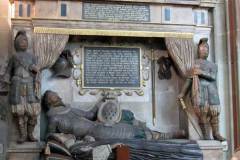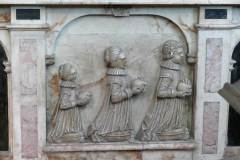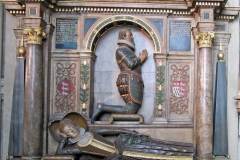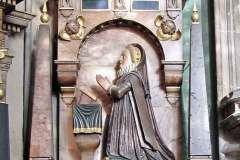Thomas Thornhurst (d.1627)
Thornhurst was a career military man who died during the Huguenot rebellion against the French Crown, when the English forces unsuccessfully attempted to lift the siege at La Rochelle. The jingoistic inscription says he “fell not without acquiring glory to himself, and victory to the English.” He lies recumbent on one elbow in military costume alongside his wife, Dame Barbara who died two years later. His three children, kneeling and holding skulls, symbolising an early death, act as weepers.
The tomb is of alabaster, some of which has been painted. An inscribed panel seemingly of a Black Marble, rather than painted black, summarises his life. The tomb stands on a plinth of Caen Stone. What is of greater interest are the eight panels of pink marble. The general appearance is of a brecciated limestone and possibly Breccia Pernice from the Veneto, near Verona; a Jurassic limestone containing fragmented marine shells.
Lady Mary Thornhurst (c.1544- 1609)
An impressive wall monument with a stiff, semi-recumbent effigy of Lady Mary. She was thrice married and shown kneeling above as chief mourner is her third husband Sir Stephen Thornhurst, who survived her by seven years.
The monument is essentially of alabaster, much of which presumably underlies the painted and gilded features. Two Corinthian columns support the ornate pediment. The columns are a pinky-brown nodular limestone with shelly debris, and numerous calcite infilled cavities and irregular calcite veins, the latter of which are beginning to weathering out.
On the outer side of each column stands an obelisk of grey marble, with darker parallel banding, possibly concentrations of graphite originating in an organic-rich limestone. The lower black panels appear to be painted in imitation of marble.
Dame Dorothy Thornhurst (c.1565-1620)
Dorothy Thornhurst married her second husband Stephen Thornhurst. The Latin inscription tells us her ashes were mixed with his within the chapel. Her will stated her wish for her niece, the executor, “to cause and procure to be made the picture [effigy] of my said Bodie of Alabaster stone, and neere or upon the Tombe of my said late husband… and place the same kneeling behind or before the picture of my late husband … for £40…”. Dorothy and Stephen now face each other on adjacent monuments. In accordance with her wishes Dorothy’s wall monument was constructed of alabaster and presumably her painted kneeling effigy is of the same stone. Two obelisks flank the monument, also of alabaster.
Click below to enlarge the images and read the captions.




